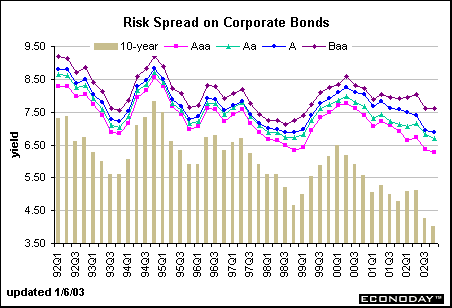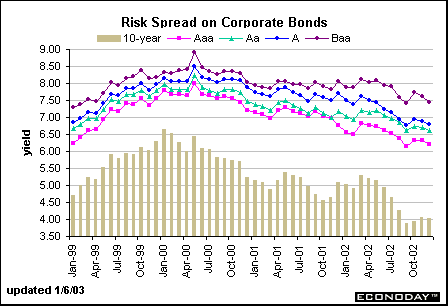 |

Long Term Perspective
The 10-year Treasury bond has become the benchmark security from which corporate interest rate levels are derived. Here we show the variation in interest rate levels on corporate bonds rated by Moody's Investor Service. Triple A rated bonds have the lowest risk of default, whereas the Baa bond has the highest default risk among this group. (Junk bonds are usually rated triple B or even C.) Thus, investors would choose the Treasury security for the lowest default risk, but also the lowest yield. To achieve a higher yield, investors need to increase the risk level. The spread between Treasury securities and corporate bond yields are not uniform over the business cycle. Spreads widen during recessions because default risk is higher for all corporate bonds. Spreads narrow during boom times because the risk diminishes when the economy is healthy.

| Spread between Treasury Note and: | 1990s Average | 2000 to 2002 Average |
| Aaa Corporate Bond: | 106 basis points | 185 basis points |
| Aa Corporate Bond: | 129 basis points | 212 basis points |
| A Corporate Bond: | 145 basis points | 244 basis points |
| Baa Corporate Bond: | 183 basis points | 282 basis points |
Short Term Perspective
The spread between corporate bond yields and the 10-year Treasury note began to widen sharply in the late 1990s and 2000. The widening in 1998 and early 1999 was due to the global financial crisis. In 2000, the Treasury announced a program to buy back old long bonds - and to reduce the supply of newly issued long bonds. As a result, the demand for long bonds increased and boosted prices (causing yields to dip). In 2001, The Treasury went further and announced an indefinite suspension of 30-year bonds. Consequently, this boosted the demand for 10-year securities and lowered yields across the board. In addition, the recession in 2001 along with a sub par recovery in 2002 caused spreads to widen as default risk increased.
The spread between 10-year Treasury yields and corporate bonds of all risk levels (from Aaa to Baa) remain wide, although corporate yields fell across the board in December. The wide gap between the risk-free Treasury note and corporate bond yields is disconcerting for this stage of the economic recovery and suggests bond investors are still uncertain about the near term economic outlook.

 |


About the Bond Market • Bond Market Charts • Treasury Market Charts • Treasury Auctions
|
 |